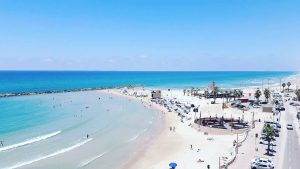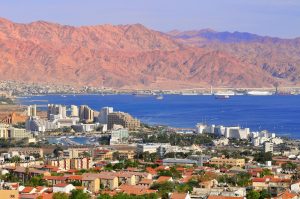Israel Morphology
Israel’s weather varies because of several climate typologies due to Israel’s position between the eastward Mediterranean Sea and the West Asia desertic regions. Israel is located in West Asia, at the far eastward edge of the Mediterranean Sea. The Mediterranean Sea surrounds Israel in the west and the Red Sea in the south, Lebanon and Syria in the north and northeast borders, the West Bank and Jordan in the east, Egypt in the southwest, and the Gaza Strip in the west. The weather of Israel is mainly affected by the Mediterranean Sea, the Saharan, and Arabian deserts. There is Mediterranean weather in the northern and westward areas, characterised by hot summers and cold winters. The central region starts from the north of the Negev Desert, and it is featured by semi-arid weather. There is a desertic climate that is humid and continental in the Southwest section in the southern part.

Different Regions Of Israel
Israel’s topography varies from snowed mountains in the north to semi-arid regions in the south’s centre and deserts. Jerusalem stretches over the summit of a mountain chain that extends from north to south, alongside the shore. The west coastal region starts from Gaza in the south, and it stretches up to Lebanon in the north. In the eastward part of the coastal plains, the Central Hill region includes many hills and lush valleys. The Jordan Rift Valley with the Jordan River, the Dead Sea, and the Sea of Galilee further east. In southern Israel, the Negev desert composes half of Israel’s land area with the Jordan River, which is the longest river measuring 199 miles. Furthermore, in Israel, there is the biggest freshwater lake, i. e. the Sea of Galilee. Another suggestive place of this beautiful country is Mount Meron, which is the highest point in Israel at an altitude of 1208 meters, and the Dead Sea is the lowest point on Earth at 417 meters below sea level.
The Weather Of Israel During The Year
Israel has long, hot, and dry summers. Indeed, there is a hot and dry wind blowing from the southern desert region in the summer. Moreover, the summer average temperatures vary between 22.2°C and 37.8°C. Especially in the Negev Desert in the south, the temperatures can be extremely high, between 44.4°C and 46.1°C. While Israel’s winters are mild in the central and southern regions, they are relatively cold along the Mediterranean coast. In the north and west of Israel, the cold season is humid; nevertheless, the south’s rains are scarce.

Desertic winters have temperatures fluctuating between 6.1°C and 22.8°C in the daytime, while in the nighttime, temperatures rarely descend below 0°C. At altitudes above 750 meters, the winters are usually cold and breezy in mountain areas, with some snowfall per year—the height, latitude, and closeness to the ocean influence the weather. Generally, springs and autumns are brief, moderate, and often dry.

Israel has few annual precipitations that vary between 30.5mm in the extreme south and 889mm in the north. More than 70% of the yearly rainfall happens essentially between November and March. The northern regions are the most humid ones, and the southern ones are the driest. Most of Israel gets a massive amount of sunshine equivalent to an annual time ranging from 3200 hours to 3600 hours.

Additionally, the average humidity is less than 50%, with the highest values on the western coasts and the lowest in the south. The seawater temperatures in Tel Aviv fluctuate between 17.2°C and 27.2°C. On the Red Sea coast, in Eilat, the seawaters are the country’s warmest ones because their temperatures change between 21.1°C and 27.8°C, which means that they are suitable for swimming even in the winter. Tirat Zvi in the Jordan Valley retains the record for the highest temperature in Israel and Asia with a value of 54°C, established on June 21, 1942. Merom Golan owns the record for the lowest temperature with a value of -14.2°C, reached on January 10, 2015.
Weather disasters in Israel
Israel sporadically faces natural weather dangers. Indeed, Israel rarely experiences natural disasters such as earthquakes, forest wildfires, sandstorms and windstorms. In the eastern and southern central regions, the rainfalls are scarce; hence there are frequent droughts. In the semi-arid and desert areas during summertime, temperatures are higher than 48.9°C, mostly during heat waves. Sandstorms cause hot air masses to blow hot sand and dust particles over large distances. Earthquakes are relatively rare, and in case they happen, their intensity is usually minor and cause slight injuries.
The Best Periods To Visit Israel
The best periods to visit Israel are the springs and autumns. In particular, April’s month is an excellent time to visit archaeological sites and enjoy a fantastic holiday on the Red Sea coast. The Mediterranean Coast weather is warm starting from May until October, and the seawaters are suitable for swimming with average temperatures in the 25°C to 27.8°C range. October and November are pleasant months to visit the Red Sea coast and the internal part of Israel. The quality of the Red Sea waters is due to its temperatures that are warmer than the Mediterranean Sea waters. Moreover, autumn and spring offer suitable sunbathing.







